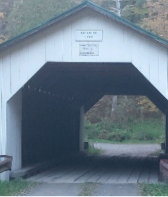Pearl Visits Historic Covered Bridges
- Ruby B
- Nov 26
- 3 min read
Pearl spends a great deal of her time swimming in The Missisquoi and Trout Rivers. Every once in a, while she looks up and sees a covered bridge and wonders what those are. To find out more, Pearl visited the six covered bridges in Montgomery and Enosburgh of Franklin County to learn!

To start, she took an inventory of all of the bridges. Immediately, she noticed that all of bridges were built in the same time frame and by the same people. From 1863-1890, The Jewett Brothers kept busy by building covered bridges. Sheldon and Savanard Jewett were
the main constructors of the bridges.
They Jewett family operated a sawmill on West Hill which enabled them to mill the wood to their specific requirements. Their wood of choice was hemlock due its strength and durability. The design of the bridges, based on American architect out of Connecticut, Ithial Town’s lattice truss, accommodated all things Vermont such as the weight of snow, full wagons, and logging vehicles.
The concept of a covered bridge is nothing new, even in 1800's Vermont. However, this is when they reached the height of their popularity in America. The concepts of a covered bridge can trace all the way back to Medieval Europe and possibly even earlier. One of the first documented covered bridge in America was built in Philadelphia in 1805. The main functions of a covered bridge are to to protect its wooden structural components, such as trusses, from weathering. This significantly extends the lifespan of the bridge from about 20 years to over 100. Another function is to provide shelter for travelers, and of course provide a crossing from land over a water way.

Getting back to Vermont, there are currently about 100 covered bridges in the state. This is far less than 700 that once existed in the 19th century. The Jewett brothers built seven covered bridges, six of which still exist today. Montgomery is even known as the covered bridge capital of Vermont! Pearl is going to tell you a little about each covered bridge below.
Longley Covered Bridge, built in 1863 and can be found on Longley Bridge Road, off of Route 118. The Trout River can be found flowing under this bridge.

Hopkins Covered Bridge, built in 1875 and can be found on Hopkins Bridge Road, off of Route 118. The Trout River also flows under Hopkins Covered Bridge.
Creamery Covered Bridge, Comstock Covered Bridge, and Hutchins Covered Bridge were all completed in 1883 in Montgomery. You can find these bridged on Creamery Bridge Road, crossing West Hill Brook, Comstock Bridge Road, spanning The Trout River, and Hutchins Bridge Road which crosses over South Branch Brook.

Fuller Covered Bridge was built by the brothers in 1890 and sits on Fuller Bridge Road, crossing Mill Brook.
Hutchinson Covered Bridge was also built by The Jewett Brothers in 1883 and could be found on Gibou Road but unfortunately, it was removed and placed in storage.
In 1974, all of these bridges were placed on The Vermont Registry of Of Historical Places and in recent years, many of the bridges have undergone updates and remodels to look like what we know them as today.
Whether you are looking to see these covered bridges by car, foot, or water, Pearl encourages you to head out into the Watershed and check them out! It is important to note that caution should be used when exploring these narrow covered bridges. Be sure to take some pictures and share them with us on social media @mrbavt. Happy adventuring!
















